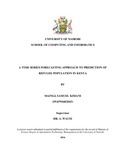| dc.description.abstract | Kenya has for many years been referred to as the Oasis of Peace in the Sea of Instability, this is due to the country’s geographical and political position as a safe haven for refugees fleeing from war and civil unrest from neighboring countries of Somalia, Uganda, Rwanda, Burundi, South Sudan, Sudan and Democratic Republic of Congo. By the end of December 2015 the total number of refugees and asylum seekers in Kenya was close to 600,000, more than half of that population arrived between 2011 and 2014 alone. Management of refugee affairs requires a diligent approach to availing resources when required (during a refugee emergency) or relinquishing resources when numbers decrease, both actions of response cannot be achieved without an effective methodology for predicting future refugee population.
This paper uses trend analysis using Weka data mining software. The data used for this project was extracted from the population data reported by the United Nations High Commissioner for Refugees (UNHCR) in the organization’s public statistics portal. The methodology used for implementing this project is CRISP-DM which guided the extraction and preparation of data to feeding it to the data mining tool. A number of algorithms were tested for against the historical data and Multilayer Perceptron which is based on regression was found to be most preferable for creation of prediction models.
The study revealed that the models created through training on the historical data performed quite well. The end of year 2016 prediction was compared against the population figures reported at the end of September 2016 and they were found to be within acceptable range. One aspect that was found to affect the prediction was uncertainty, the study revealed that drastic changes in refugee population such as through outbreak of violence in the refugee countries of origin could not be captured by the trained models therefore the use of expert input adopted to complement the trend learned by the models.
The paper concluded by providing recommendations which emphasized on the use of a hybrid approach in handling uncertainty through the use of the expert input and probability functions to calculate the likelihood of selected factors impacting the population as proposed by the experts. In addition the research recommended a sectoral approach to population prediction to look at aspects like prediction of malnutrition rates, health, education etc. this would require consistent collection and storage of such information so that it can be used to train prediction models. | en_US |



